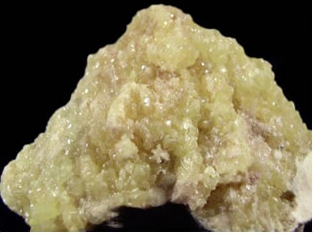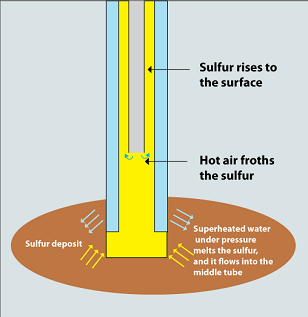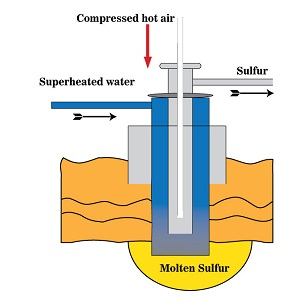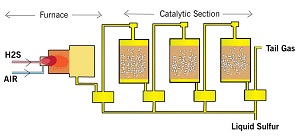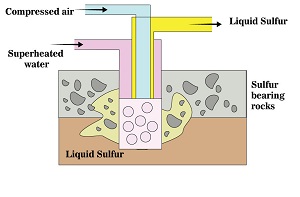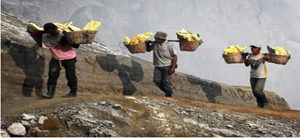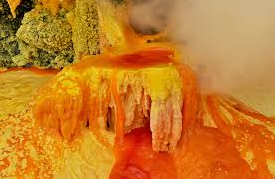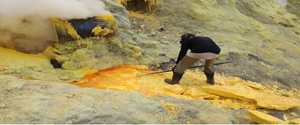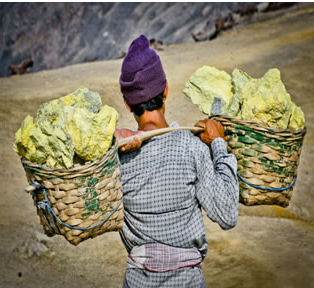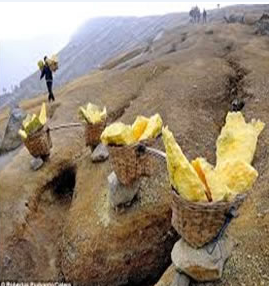SULFUR MINING:
Sulfur is a multivalent non-metal which is tasteless and odorless. It appears to be a yellow crystalline solid in its native form. Its occurrence in the nature is as a pure element or as sulfide and sulfate minerals. It is one of the most important elements which is essential for life and can be used in various ways for many purposes. This element is used in the preparation of sulfuric acid. It is mostly used in the industries for steel and rubber making purposes. It is also used for producing inorganic chemicals, matches, fumigants and glass. It is also used in explosives, cement, animal feed and adhesives.
The element can be found in many natural resources. It can be found in water, mineral springs and Epsom salts. The other sources are gypsum, barite, zinc blende, cinnabar, galena, iron pyrites and other ores and minerals. This element is mostly found in volcanic regions and underground deposits. Some of the biggest deposits are known to be found in Louisiana and Texas. The element occurs naturally in natural gas, petroleum and coal.
OCCURRENCE IN NATURE:
The abundance of the element in the earth?s crust is about 0.042%. In the previous times, sulfur was said to have occurred in layers along the surface of the Earth. They were easy for humans to find and take. Such deposits are very difficult to find today. One place they still occur is in the vicinity of volcanoes as they are released from the volcanoes in the form of gas. On reaching the cold air, it changes back into the solid form and forms beautiful yellow deposits along the edges of a volcano.
Large amounts of sulfur still occur underground. They are removed by the Frasch process. It ranks about number 16 among the elements in terms of their abundance in the earth. The largest producers of sulfur in the world are the United States, Canada, China, Russia, Mexico, and Japan. In 1996, the United States produced about 11,800,000 metric tons of sulfur. It is mined in 30 states which includes the Puerto Rico, and the U.S. Virgin Islands.
PRODUCTION:
?Sulfur is commercially generated because it is essential for various purposes. The most common method to produce sulfur is to sink wells in places with salt domes. They are also available in areas with petroleum and natural gas. The most well known methods used for its production are the Sicilian and Frasch processes.
- The Sicilian method uses sulfur bearing ores and burns them from which heat is generated and the sulfuric elements are burned to be collected as a result. The elements are then purified by sublimation.
- The Frasch method was put forward by a German-American chemist, Herman Frasch in 1887. This method is based on the low melting point of sulfur in which a set of three nested pipes are made to sink into the ground. The innermost pipe has a diameter of an inch, whereas the middle pipe has about four inches and the outer pipe has about eight inches. A stream of superheated water is injected into the outer pipe which passes down to reach the underground sulfur, causing it to melt and a molten sulfur is formed like a lake at the bottom of the pipe. At the same time, a stream of hot air is pushed down the innermost pipe which stirs up the molten sulfur and hot water at the bottom of the pipe. As a result, a foamy liquid mixture of sulfur and water is formed. The mixture is then forced upward through the middle pipe. On reaching the surface, it is collected and later on, the sulfur cools and separates from the water.
From the late 1800s to the end of the 20th century, the Frasch process of sulfur mining was commonly used. During the latter part of the 20th century, mining or recovering sulfur as a by-product of natural gas production or oil refinement became more significant. Over the course of time, sulfur has been one of the most basic mined materials used in industrial production processes, which have been made more efficient and cost-effective through the technological advancements of mining machinery.
WHERE IS SULFUR FOUND:
Sulfur mining takes place in countries such as Poland, Ukraine, United States, Russia and Turkmenistan. Until the late 19th Century, there were sulfur mines in volcanic countries such as Italy, New Zealand, Chile and Indonesia. There are still volcanic sulfur mines in the Andes, but these are known to be mechanized as per studies. But one of the largest production of sulfur comes from the Ijen, a quiet but active volcano in East Java, Indonesia which contains a one kilometer wide crater lake; a well known site of sulfur mining. The water in the crater - which is one of the world's largest - is acidic enough to dissolve clothes, eat through metal, and cause breathing problems. Sulfur miners break off large chunks of sulfur from the crater floor and carry the chunks out in large baskets nearly 3 kilometers to town. This process is very labor intensive and thus the miners are able to earn anywhere between $5 and $13 per day (USD). The sulfur mined in East Java is processed nearby for use in bleaching sugar, vulcanizing rubber and other industrial processes.
MAJOR PRODUCERS OF SULFUR:
MAJOR SULFUR PRODUCERS OF THE WORLD
COUNTRY |
PRODUCTION IN (THOUSAND METRIC TONNES) |
China |
9400 |
Russia |
7100 |
Canada |
7000 |
Germany |
3800 |
THE IJEN CRATER MINING FOR SULFUR:
Sulfur mining is most popularly carried out in Indonesia as the place is well known for its volcanic regions and the large amount of sulfur contained in and around such regions. Sulfur mining is done in volcanic regions where the element is found in high amount. Gunung Ijen in Indonesia?s eastern Java is a volcanic wonder which is 2,799m (9,183 ft) above the sea level. The Ijen volcano complex is a group of composite volcanoes in the Banyuwangi Regency of East Java, Indonesia. It isn?t lava, but the sulfur for which the crater of Ijen is renowned.
The sulfur miners of Ijen crater region in Indonesia lead a very difficult life as they face everyday challenges with high risks and uncertainties. They are the men who treat poisoned lungs, burns, scars and constant danger as part of their everyday living. They make their tiring journey climbing 9,000 ft. to the summit and then 3,000 ft. down into the crater. The miners descend to the womb of the volcano, defying scorching heat and rarefied air, in search of the precious material that is used to manufacture countless products.
The miners carry bamboo baskets with them and head towards the mountainous regions in order to collect the sulfur and each basket has an average weight of 80kg. Since the place is a volcanic region, the miners sleep on the volcano so they can wake up early and make three sulfur runs down into the volcano and back. Once they?re on the top, the air is seen filled with sulfur smoke.? The miners scramble from the
bottom of the crater to its rim where they actually harvest the sulfur. Inside, the smoke gets very intense and the vision is fully blocked and the so they stop and wait for some time for the wind to blow in a different direction.?
The path is however steep, rocky and ripe with foul smelling toxic gases. Therefore the miners wear masks and others wear boots but still they seem poorly-equipped overall. Some just wear a piece of wet cloth so that they can help themselves breathe a little and also protect themselves from the caustic gas that singes the eyes, throats and lungs,and that which can even dissolve teeth. Pipes are driven into the fissures in the rock to extract sulfur from the depth of the mountains.
It is blood red when molten, and turns yellow as it cools and solidifies. The molten sulfur emerges from the pipes which is deep blood red at first, and gradually turns to vibrant yellow as it cools and hardens into pure sulfur. The big sulfur chunks are then removed from the pool and hit with rocks so that they can be fragmented into maintainable sizes.? There is not enough oxygen and the smoke is extremely toxic. The miners escape the smoke as fast as possible as breathing within it is almost impossible.
The acidic crater lake is filled with a mixture solution of sulfuric acid and hydrogen chloride at a temperature of about 33 degree Celsius. It takes more than an hour for the miners to cut the sulfur and load it into the buckets. The miners carry loads of sulfur ranging in weight from 75 to 90 kg on the whole. Each day, they go up the mountain and gather 90 kg loads from the toxic lake, which they then have to carry back to a weighing station at the base of the volcano; and they do this several times per day.
The miners really suffer incredibly at the end of the day with terrible injuries in their shoulders and back as they carry huge baskets of sulfur which weighs double the times of their own body weight. Their earnings are very less as they ?get to earn just 900 rupiah for each kilogram of sulfur they carry which sums to around 55,000 -60,000 rupiah for 70 kilograms of sulfur on the whole. In the past 40 years, 74 miners have died because of fumes that come from fissures in the rock, more specifically hydrogen sulphide and sulfur dioxide gases, which are so concentrated they can even dissolve teeth, let alone the other parts of the body.
Such physically demanding and hazardous work means miners? average life expectancy barely reaches 50 years. Their bodies seem to be worn out due to the endless amount of hard work they put in, but nevertheless they continue to do so with pride even in pain and injuries.
